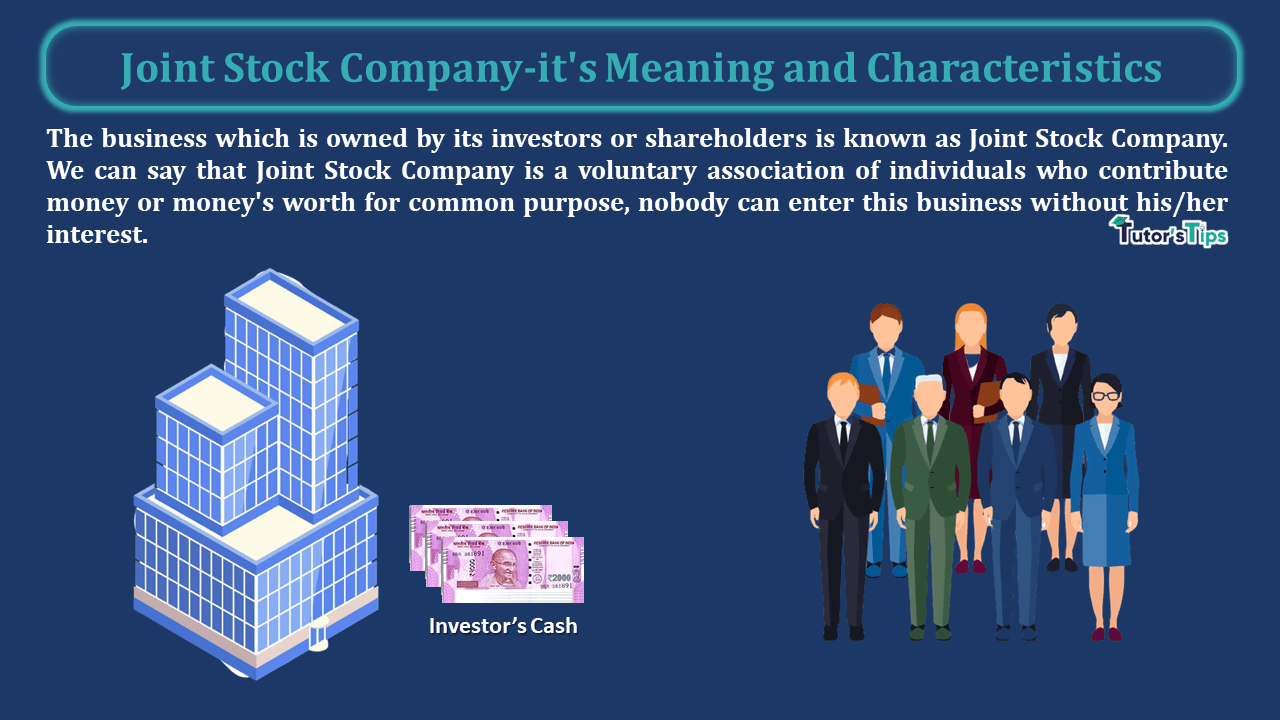The Joint Stock company form of organizations is more suitable when the activities or operations of the business are run at large scale because large scale business needs large capital which is not possible by one person.
Meaning of Joint Stock company:
The business which is owned by its investors or shareholders is known as Joint Stock Company. We can say that Joint Stock Company is a voluntary association of individuals who contribute money or money’s worth for common purpose, nobody can enter this business without his/her interest.
By issuing shares, the company can raise funds from the public. For making large scale investment, public funds are used for operations like – production of goods, expansion, purchasing assets etc.
Definitions of Joint Stock Company:
“Joint Stock Company is meant as an association of many persons who contribute money or money’s worth to a common stock and employ it for some common purpose.“
-Justice Lindley
“A joint-stock company is an artificial person, invisible, intangible and existing only in the eye of law.”
-Chief Justice Marshall
“Joint-stock company is a voluntary association of individuals for profit, having a capital divided into transferable shares, the ownership of which is the condition of membership.”
-Prof. Honey
Characteristics of Joint Stock Companies:
For more clarity about the joint-stock company, let’s move towards the characteristics which are as follows:
Advertisement-X
1. Legal entity Joint Stock Companies:
Company and its members are separate individuals. All the operations of the company are carried on in its own name, and it can buy or sell assets in its own name. In the company form of organisation, the board of directors can manage all the operations of the business by using the stamp of the company they cannot use their own name in the place of the company name.
2. Artificial person:
Company is an artificial person created by law. We can say that all business activities are performed by all human resources but it does not mean that company is a natural person. we use the name of the company while doing any business operations.
3. Registration:
This is a legal formality which is compulsory for the formation of the company. Without registration of the company, operations can’t run smoothly.
Under Companies Act, 1956 every company has to be registered itself for doing business without difficulty.
4. Common Seal:
The company cannot sign itself, all the activities are carried through a group of people who are connected with the company. So anyone acting on the behalf of the company can use the common seal (stamp) in place of signature of the company.
Any document without the stamp or a common seal is not considered as a legal document of the company.
5. Transferability of shares:
The shares of the company are freely transferable by its members. Any member who want to sell his shares then he can free to sell and withdraw his membership from the company.
In the case of public company transferability of shares is easy but in the case of the private company no member can sell his share or transfer the share easily.
6. Ownership and control:
The company and its members are separate from each other and if we are talking about the ownership, shareholders are the owners who owned and invest in the company. If we are talking about the control, then shareholders are elect a board of directors for controlling the overall operations of the business.
So, we can say that ownership and control are different. Company is owned by shareholders and control of the operations of the company is in the hands of the board of directors elected by the owners of the company.
Advertisement-X
7. Liability:
In the company, members have limited liability to the extent of their share capital contributed by them.
For example: if a person has purchased 2000 shares of value Rs 10 each, then his liability is limited up to Rs. 20,000 only.
8. Continuous Existence:
A company has continuous existence and it is independent of its members. Members may come and may go but the operations of the company not affect. The company can only be windup through the legal procedure.
Thanks for reading the topic.
please comment your feedback whatever you want. If you have any questions, please ask us by commenting.
References: –
Also, Check our Tutorial on the following subjects:
- https://tutorstips.com/financial-accounting/
- https://tutorstips.com/advanced-financial-accounting-tutorial/
Advertisement-X







1 Comment